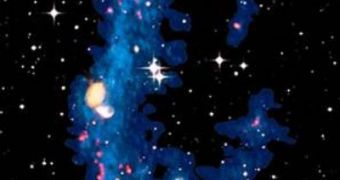Dark matter is a concept than has been widely discussed in the last years among astronomers. So far, most theories have been trying to explain the origins, properties and purpose of this exotic matter.
Unfortunately, until now, none of the astronomers can say what this illusive matter looks like, although recently there have claims of solid proof of its existence.
A couple of the dark matter "hunters" have turned to some unusual places in the galaxy for their quest, in the hope of finding its hiding place: "recycled" dwarf galaxies produced from huge galactic collisions.
Now, they have come up with yet another theory and they say this time, they have the pictures to prove it. It says that dark matter doesn't hang out in halos around large galaxies. Instead, it might be found within the galaxies.
Its role is that of a gravitational super glue, holding together billions of stars in the same galactic disk. Without it, "our own galaxy should have fallen apart by now," said Frederic Bournaud, an astrophysicist with the French Atomic Energy Commission. "So dark matter - this unseen force - is somewhere keeping it glued together."
Bournaud thinks he and his team have come closer to actually finding and identifying more of the universe's missing mass by combining every method available: telescope images, calculations and computer models.
To find out more about dark matter, they pointed the Very Large Array of radio telescopes in New Mexico at NGC5291, a galaxy cluster about 200 million light-years away. The cluster looks like a ring, crowned with one large galaxy at the center and studded with smaller dwarf galaxies in a cloud of cosmic debris.
"About 360 million years ago a large galaxy collided with NGC5291, which used to be a spiral galaxy," Bournaud said and he thinks the dark matter resulting from the collision probably lurks within the galactic boundaries of dwarf galaxies, not in a halo around them.
Although he says that "that's only a guess," he presented some interesting simulations that he claims, show anomalies where dark matter could hide.

 14 DAY TRIAL //
14 DAY TRIAL //